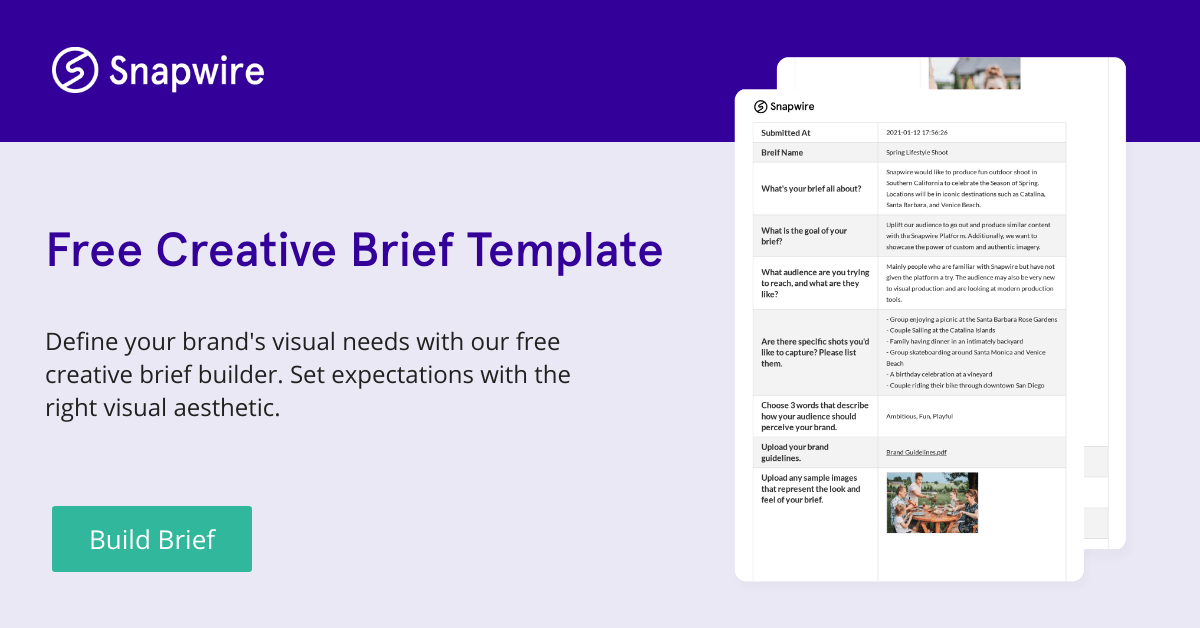When working on content marketing of any sort, having a clear sense of vision and purpose to direct your marketing team is invaluable. "Begin with the end in mind," the saying goes, and the number of creative projects that have failed as a result of ignoring this wisdom is disturbing to consider. Profit was lost, companies failed, and otherwise-brilliant initiatives never got off the ground because they lacked clear project goals and a brand voice to sculpt their project's formation. The failure to form a good creative brief doomed them from the start.
To keep that from happening to your creative project, make sure your marketing team is equipped with the knowledge of your product that they need and a sense of your brand guidelines without weighing them down with unnecessary constraints. Understand how to make a creative brief that informs and empowers, and your project will have a foundation to build into a successful product launch. Here's what to think about as you go.
What is a Creative Brief?
At its core, a good creative brief serves as an outline. While it may take many forms - a PowerPoint presentation, a Word/Page document, etc. - the ultimate goal of the creative brief is to detail the information that marketing teams must know to direct them through the content formation process.
This brief will often be generated by the creative director, or project manager, in conjunction with the client, requiring close interaction between client and agency. This allows accurate execution by the internal team, including graphic designers and copywriters.
No matter who creates it or how elaborate its details are, what counts is that the client's vision and brand guidelines are adequately articulated and that the creative team has the information needed to project their brand voice to the target audience.
Relationships First
"I don't believe in briefs, I believe in relationships," says Yves Behar, CEO of FuseProject, conveying the need for client interaction and vision-sharing over documents that restrict the scope of project execution. CEO of 72andSunny John Boiler echoes the sentiment, saying, "In really practical terms, we say no to clients who come to us wanting a marketing campaign. We say yes to clients that have exciting problems and opportunities and want a long-term relationship."
This sort of collaborative inclination on the part of the modern advertising agency is indicative of the need for relationship-building. Community-focused thinking is essential in a digital age where marketing teams are no longer charged merely with creating ads but with driving results and connecting with target demographics as people first. The necessity for client-marketer relationships by no means undermines the need for a good creative brief; it just shows that collaboration must always be at the forefront.

Keeping it Brief
Although some may thoroughly detail the entire scope and history of a project, the most effective creative briefs are often concise, open-ended vision statements that clearly articulate a client's brand guidelines, target audience, and brand voice.
Overly elaborate creative briefs often do little more than tie the very marketing teams' hands from whom a client is seeking assistance. The surprising overtake of the Apple iPhone by the Samsung GS2, for instance, was substantively founded upon the refinement of the Android operating system as well as improved screen brightness and functionality. Still, the line that drove the ad campaign was, "We want to be a credible number two to the iPhone leader."
Without excess specificity or unnecessary constraints, a good creative brief should seek to inform the marketing team of the required brand guidelines and give the team members the freedom to do the job.
Important Elements of a Great Creative Brief
Without further ado, here are some possible factors to include within a creative brief that can effectively keep your project moving forward. Some are essential, while others are nice to have.
Bear in mind, this is not a comprehensive list; only the client and marketing team know all the questions that need to be asked during project development for specific goals.
Product Details
- What is the product? - Give a brief description of the product, its place in the market is, how it helps the customer, and how it's changing or has changed in the past.
- What does it do? - What is the purpose of your product, and how does it connect to its users? How is it different from its competitors, and why does your audience need to know that?
Target Audience
- What's your target market? - This includes your target demographic data, including basics like age and income. Don't forget psychographic data, too: what are their pain points/preferences/desires?
- What is their lifestyle, and why do you matter to them? What do you want them to do? - Once you've conveyed your key message, what behavior or attitude are you trying to stimulate within them? Do you want them to buy a product? To share a post? To feel a certain way? To join your movement? What action do you want to trigger?
Market Insights
- What crucial knowledge have you gained about your target audience, or in what fundamental way has your product evolved such that the project cannot go forward without this insight?
- Who are your main competitors and products? How does the competition market their products?
Communication Channels
- Medium - In what channels will you be communicating to your audience? Social media? Billboard ad? Magazine cover? How does your audience respond to being engaged within the medium you're choosing, and what communication style do they expect to hear from that medium?
- Mandatories - What information about the product is indispensable? Does a style guide with certain logos, brand names, or taglines need to be mentioned?
Deliverables and Objectives
- By the time you're done with your creative project, what tangible products does the client expect you to have produced? A commercial? A YouTube video? A product line? What are you expected to come up with? (More on how this connects with specific kinds of creative briefs later.)
Many questions could easily be added to a creative brief and provide valuable insight on where the project should go, but answer these essential questions, and you'll be well on your way to a solid, non-constricting brief.

Additional Information
Even after you've answered the essentials, there are still many questions left to be asked that will likely play a significant role in the shape the project takes. Some of them are better left unanswered with latitude given to the creative team regarding how to handle them, but some will need to be addressed. Here are a few:
- Timeline - Nearly every project has a deadline of some sort, but some projects may be more flexible than others in their expectations of what is to be delivered when. What hard deadlines must be met for this project to be deemed a success?
- Budget - As with a timeline, few and far between are the projects that are funded with a blank check. You may find a few creative projects where the client will spend whatever it takes to achieve their goal, but for the most part, financial constraints will have to be considered when defining the scope of a project.
- Brand Voice - Depending on the project, it may be best to leave this one to the creative team. If there is a specific note that must be struck throughout the communication of the message - a patriotic tone for an all-American product or an adventurous tone for a line of camping gear - that information could be critical to convey.
- Cliches - What tired, overused images, narratives, and storylines do you want to break free from? Is there a difference between those and time-tested truths that need to be maintained in your message, even if there's a need to present them in an original way?
Ultimately, it's up to the client to decide which questions are essential and which can be left to the advertising agency's discretion in forming a brief - hence the necessity of close relationships between the client and marketing team. However few or many are deemed necessary, the above launching points are usually present within most creative briefs on some level. As long as the advertising agency is brought into a sufficiently intimate understanding of what the product is and how they can achieve all required project goals, the question of how many talking points need to be present is irrelevant. A successful brief can be quite succinct. Once you know that, the only question left is what kind of message platform you'll be delivering and understanding how that shapes your presentation style.
Is there an ideal Creative Brief Template?
Although it is universally accepted that some type of creative brief is necessary for sculpting and informing content production, the role and form of the creative brief have changed substantially with the digital era's progression.
If the objective of a marketing team is strictly to generate an ad campaign by delivering a specific message, a good creative brief will likely take a very explicit form, telling the advertisers what to say and roughly how to say it. In a digital world that demands results from content producers rather than just ads, a brief will likely look much more open-ended and fluid than in generations past.
In his article entitled "Thoughts on the creative brief," Professor of advertising Edward Boches writes this on modern-day expectations of advertising agencies and how they impact the briefs that drive them:
"If you accept that today an advertiser's job is to invite participation, build community, inspire sharing and even provide useful content and experiences that solve problems for a customer, you're probably making a lot more than messages. In which case, you need a different kind of brief. You need a less prescriptive brief and more likely to inspire exploration and discovery that leads to an experience. A better brief might frame what an advertiser wants to do or make happen rather than what it needs to say."
Our Free Creative Brief Template
It becomes imperative to consider what kind of delivery platform the team will be using to communicate the desired message. If the deliverable is a classic commercial that seeks to convey a single message, a more explicit creative brief is probably called for. If, on the other hand, a team's goal is to create an advertising experience that will galvanize a target audience around a particular brand or create an experience, a brief that instructs the creative team to achieve a specific final goal may be perfectly sufficient.

Conclusion
The simplest things tend to be the most profound, which is certainly the case with generating a good creative brief. Much like other creative work forms, there are no hard and fast rules dictating how a creative brief is to be formed. What counts is that a client's product and brand guidelines are clearly articulated to the marketing team, and the team has ample knowledge and freedom to direct them through the creative process without hamstringing their talent. Achieve that while maintaining a close client-marketer relationship, and you've got a successful creative brief.
 Visual Production Platform
Visual Production Platform






